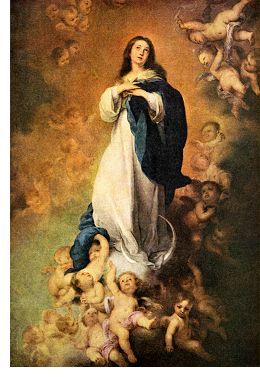 It was in 17th Century Spain that the details of the Immaculate Conception became firmly established in painting using the imagery of Revelation 12:1. Mary is the "woman clothed with the sun, and the moon under her feet, and upon her head a crown of twelve stars..."
It was in 17th Century Spain that the details of the Immaculate Conception became firmly established in painting using the imagery of Revelation 12:1. Mary is the "woman clothed with the sun, and the moon under her feet, and upon her head a crown of twelve stars..."
The Spanish painter and art censor to the Inquisition, Francesco Pacheco, added that she should be shown as a young girl on the verge of womanhood, dressed in a white robe (representing purity) under a blue cloak (representing Heaven), and a girdle with three knots (like the Franciscan habit, signifying poverty, chastity and obedience), with her hands folded in prayer. This prescription informs the numerous images of the great Spanish Painters from El Greco to Velázquez to Murillo.
It is easy to look at a painting like Murillo's Immaculate Conception (right), noticing only the sweetness and delicate charm of the Virgin and the angels and overlooking the imaginative power and depth of feeling of the artist. Here, he transcends the standard recipe for the Immaculate Conception to bring before our eyes a vision of a celestial being existing from all eternity, suspended in an immeasurable abyss of time and space.
|